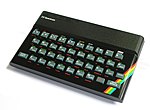ZX Spectrum Next
An editor has nominated this article for deletion. You are welcome to participate in the deletion discussion, which will decide whether or not to retain it. |
| Developer | Spec Next Ltd. |
|---|---|
| Manufacturer | SMS Electronics |
| Type | Home computer |
| Release date | February 2020 |
| Introductory price |
|
| Units sold | 3000+ |
| Operating system |
|
| CPU | Xilinx Spartan 6 FPGA |
| Memory | 1 MB (upgradeable to 2 MB) |
| Display | VGA, RGB, HDMI |
| Graphics |
|
| Sound | beeper, 3x AY-3-8912, Covox |
| Controller input |
|
| Connectivity | |
| Predecessor | ZX Spectrum 128 |
Sinclair ZX Spectrum Next is a modern 8-bit home computer, backwards compatible with the ZX Spectrum, but also featuring enhanced capabilities.[1][2]. It is intended to appeal to retro-computing enthusiasts and also to "encourage a new generation of bedroom coders", according to project member Jim Bagley.[3]
History
The ZX Spectrum Next started life in 2010 in Brazil, as a variant of the TK95 Spectrum clone. The design is based on an Altera DE1 FPGA, which implements the original ZX Spectrum's Z80 CPU.
In 2016 Victor Trucco and Fabio Belavenuto announced the "TBBlue" board, named for the two creators and the color of the solder mask of the motherboard, a bare circuit board implementation of the product for advanced hobbyists.
With the help of Henrique Olifiers the duo wanted to export the TBBlue to the UK, the ZX Spectrum's original home, having received moderate success with the board in Brazil.[4]
The Next was first announced as a distinct product in 2016 after the participation of original Spectrum industrial designer Rick Dickinson was secured. A crowdfunding campaign was launched on the Kickstarter platform in January 2017 with an initial funding goal of £250,000,[5]
After some design and production delays, the first batch of finished units were delivered to backers in March 2020.
Models
Four models of the Next have been produced:
- ZX Spectrum Next developer board (Base 1024 kb memory model that could fit in the original ZX Spectrum case with minor adjustments. The board design was changed slightly for the next three models.)
- ZX Spectrum Next with 1024 kb memory (768 kb free)
- ZX Spectrum Next Plus ads a real-time clock and Wifi over the standard Next
- ZX Spectrum Next Accelerated ads a Raspberry Pi Zero over the Plus.[6]
Further options include 2x 512 kb memory, internal beeper speaker. A real-time clock, Wifi and Pi Zero can easily be user installed in the standard model.
Reception
The Next has received generally favorable reviews in the specialist press. In the official Raspberry Pi magazine "MagPi", Lucy Hattersley called it "a lovely piece of kit", noting that it is "well-designed and well-built: authentic to the original, and with technology that nods to the past while remaining functional and relevant in the modern age".[7]
In PC Pro magazine, columnist Gareth Halfacree called the Next "undeniably impressive" while noting that the printed manual lacks an index, and that some features are "not quite ready".[8]
Visual Design
The Next's case design[9] is by the late Rick Dickinson who designed the original 48K Spectrum, but sadly passed away during the development of the keyboard of the computer.[10]
Hardware Specifications
| CPU | Z80N (Zilog Z80 compatible with additional instructions) implemented in FPGA |
| Speed | 3.5, 7, 14 or 28 MHz |
| RAM (Memory) | 768K (base), 1792K (expanded) |
| Graphics | From 128 x 96 to 640 x 256 pixels |
| Colour | Depending on mode and layer, 16 or 256 colours. No colour clash in certain modes. |
| Sprites | Up to 128 hardware sprites of 16 x 16 pixels. |
| Sound | Traditional "Beeper", 3 x AY 8910 FM synthesizers, and 4 x 8-bit DACs. |
| Software | The Next can be configured to boot into up to thirty alternate cores resident in flash memory, giving it the ability to simulate other 8-bit microcomputers such as the Acorn BBC Micro |
Software
There are more than 60 games, apps and demos already available for the Next. [11] Some titles (Baggers In Space, Warhawk and Tyvarian) were available through Next's official shop. [12] Many were sold as physical releases in DVD or PS Vita boxes with software on the SD card. The Curse of Rabenstein adventure game by Stefan Vogt/Puddle was sold as Collector's Edition.
References
- ^ Bush, Steve (April 28, 2017). "ZX Spectrum rides again, with Z80 and optional Raspberry Pi Zero". Electronics Weekly.
- ^ Beschizza, Rob (April 30, 2017). "ZX Spectrum Next is an advanced version of the original 8-bit monster machine". BoingBoing.
- ^ Crooks, David (December 2019). "ZX Spectrum Next Raspberry Pi project showcase". MagPi Magazine.
- ^ Carroll, Martyn (January 15, 2020). "Introducting the ZX Spectrum Next". Retro Gamer (UK).
- ^ "Celebrate the Sinclair ZX Spectrum's 35th anniversary with… yet another retro console". Metro (UK). April 24, 2017.
- ^ Ridden, Paul (April 24, 2017). "Home computing classic reborn as ZX Spectrum Next". New Atlas.
- ^ Hattersley, Lucy (April 2020). "ZX Spectrum Next Accelerated review". MagPi Magazine.
- ^ Halfacree, Gareth (June 2020). "ZX Spectrum Next". PC Pro Magazine (UK).
- ^ https://www.flickr.com/photos/9574086@N02/albums/72157685519763101
- ^ Halfacree, Gareth (April 26, 2018). "Industrial designer Rick Dickinson passes away". Bit-Tech.Net.
- ^ "ZX SPECTRUM NEXT GAMES". Retrieved July 28, 2020.
- ^ "RUSTY PIXELS GAME PRE-ORDER IS LIVE!". Retrieved July 28, 2020.
